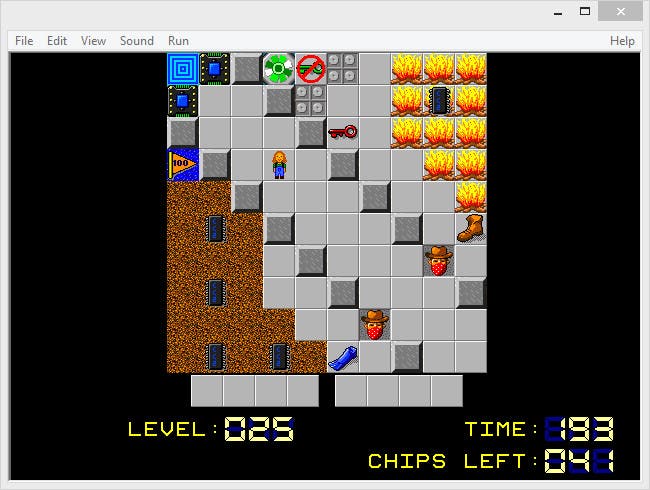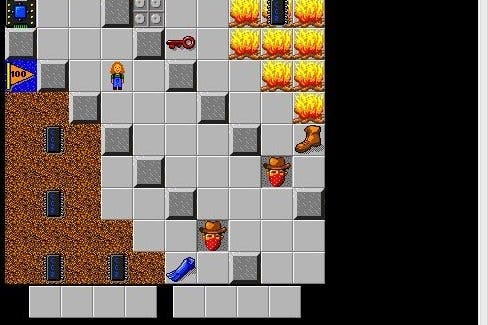Chip's Challenge 2 review
Circuit lord.
For a while Chuck Sommerville thought that he would have to die before the world could play Chip's Challenge 2. He started work on the game (the follow-up to Chip's Challenge, a well-regarded puzzler launched for Atari's battery-hungry handheld Lynx) in 1989. But after two years of development, when the sequel was ready, he discovered that the trademark had been sold. Its new holders wanted the designer to cover both the cost of packaging the game and the cost of its distribution. Unable to afford the outlay, Sommerville fell into something of a depression. He believed, according to a recent interview with PC Gamer, that "the only way Chip's Challenge was ever going to see the light of day was by having my wife leak it on the net on my death."

It didn't come to that. After five years of negotiations with the trademark holders, Sommerville finally secured the right to release his game onto Steam this year - as well as, surely, securing the world record for the longest stretch of time between a game's completion and launch. Time may not have aged the game's star, bespectacled nerd Chip McCallahan, but the game is resolutely and unashamedly of its era. It's played in a small window (there's no full-screen mode) and its bright, boxy pixels flit to a honkytonk MIDI piano score. When you die, Chip cries 'bummer', in processed computer speech. What little animation there is in the game is perfunctory at best. This would have looked and sounded out-dated in 1991. No matter: beneath the archaic presentation, Chip's Challenge 2 is as freshly ingenious as the day it wasn't first released. This is PC puzzling at its vintage finest, providing 200 levels, many of which have a memorable conceit, in which to lose a week or two, before you begin the long-term work of chasing high scores.
The premise is like something lifted from a 90s issue of the Beano. Having won the heart of Melinda the Mental Marvel (Chip's fellow student who runs the exclusive science gang, the Bit Buster Club in the first game) the pair must now take on a series of top-down 2D puzzles, in a challenge issued by the International Brain Game Club. At its most basic level, this is a game of finding the right key for the right lock in order to reach the end of the level. These keys are collected by walking over them, and are colour-coded to their corresponding door. Each key can be used just once before it disappears from your inventory and, in this way, Sommerville and the other level designers (whose names are reported before each of their various stages) build spatial puzzles. To complicate matters further, blocks can be shunted around to create pathways (a bridge through a lake, for example), and different types of terrain have different properties. For example, you slide uncontrollably when you step out onto ice and you die instantly when you touch water. Various items, scattered thoughtfully/ forgetfully throughout the levels, allow Chuck to master different surfaces (with cleats on his feet, for example, ice becomes manageable). Other doors require you to drop these items before you're allowed to pass, and through this straightforward list of rules, Sommerville and his puzzle co-designers spin delightful variety.

As well as making your way to the stage's exit, you'll also need to collect microchips along the way. Each exit (or chip socket, as they're known in the game's terminology), requires a certain number of chips before it'll open, so you must be thorough in your scouring of the scene. It pays to be quick too. You're scored on the time you take to successfully reach the exit point, as well as the number of bonus point flags you picked up en route (and, usually, acquiring these flags will use up some of the clock). Midway through the game, you are given the chance to control Melinda too, who has slightly different abilities to Chip, and is able to walk through doors marked 'Girls Only' through which he is prohibited from passing.
Water isn't the only peril here. Later stages introduce bugs such as ants and centipedes that roam the stage, killing you instantly on contact. In many levels it's easy to use a key in the wrong door, or to shunt a block in order to render the level unsolvable. In this case, the only recourse is the blunt restart which, in some cases, will undo a significant amount of work. For players who grew up in today's more forgiving era of game design, these strict, arguably inelegant terms will prove off-putting. There's a certain degree of trial-and-error to progression, and the difficulty curve is frequently uneven. The designers get around this, to a certain degree, by allowing you to skip any level without penalty, or to use the level select to jump to a specific puzzle. But, rather like Treasure's Bangai-O HD, the level select feels a little like a brute force solution to a problem that might have been more elegantly solved through pacing.
In time, however, you may come to take a different view. Chip's Challenge 2 is perhaps best approached like a puzzle book, into which you can dip, skipping around between pages, returning to conundrums you were previously unable to solve, or racing ahead to sample something different. The level select screen acts like a table of contents, and reports your best score for the stage, as well as your best time, aggregating your scores to give a grand total for the entire game. It's a gruelling, delightful, sometimes infuriating ride, but one that was well worth the wait.


